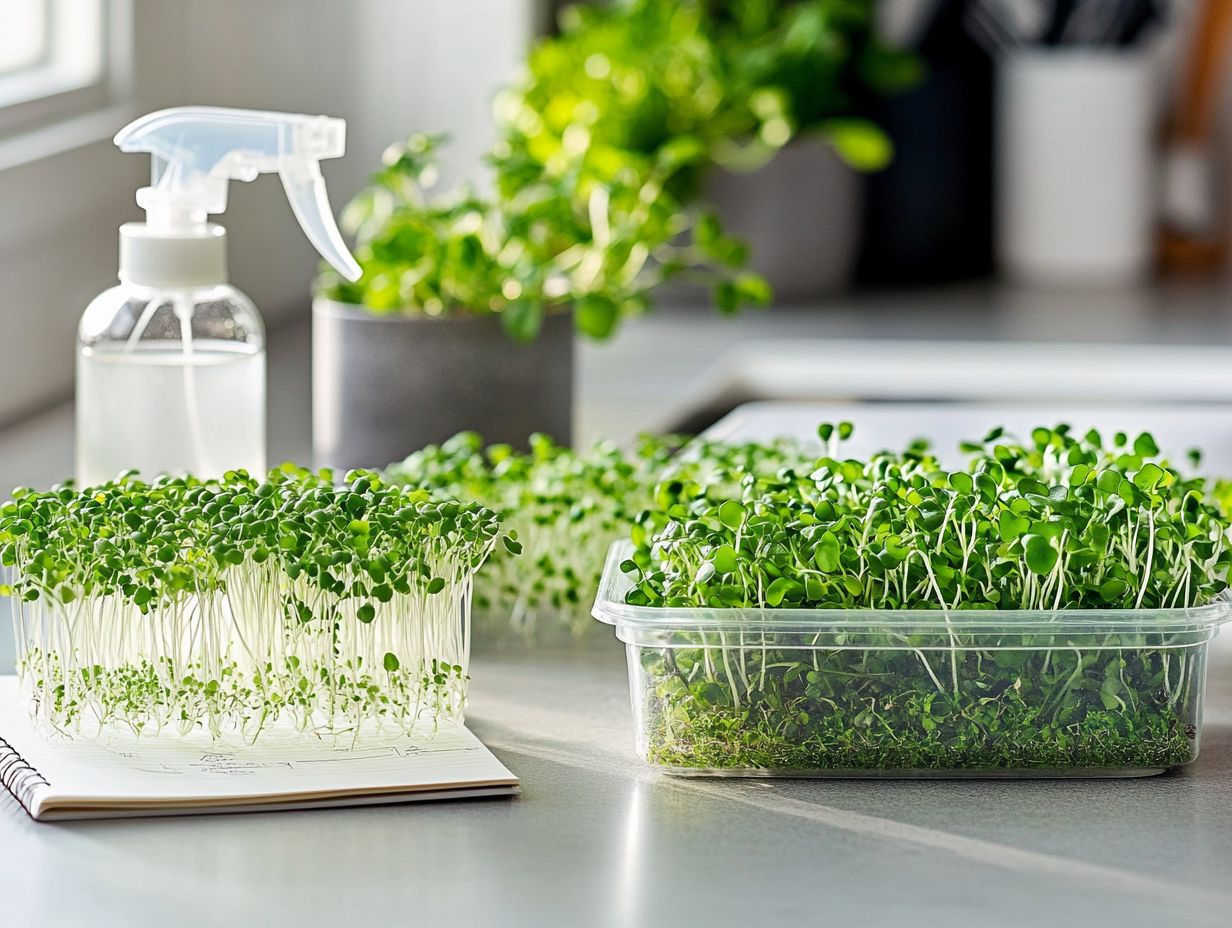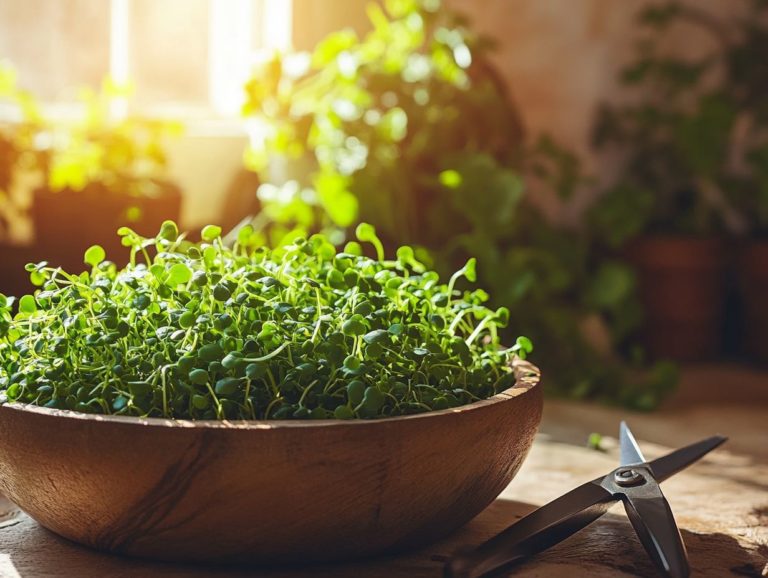Storing Microgreens: Tips for Freshness
Microgreens have surged in popularity, not only for their vibrant flavors and impressive nutritional benefits but also for their remarkable versatility in the kitchen. These nutrient-rich superfoods are gaining recognition for their health benefits. However, keeping them fresh opens a world of culinary possibilities.
This guide provides you with everything you need to know about microgreens from grasping their essence to reaping the benefits of proper storage. It also covers the best ways to grow them at home. You will learn about the factors that influence their freshness, effective storage techniques, and practical tips for incorporating them into your meals.
Prepare to elevate your culinary experience with these nutrient-rich greens that can be easily added to salads, smoothies, and various dishes! Don t miss out on experiencing the incredible flavors of fresh microgreens!
Contents
Key Takeaways:

- Store microgreens properly to preserve their freshness and maximize their health benefits.
- Temperature, humidity, and light are key factors that can affect the freshness of microgreens.
- Effective storage techniques and proper use of stored microgreens can help extend their shelf life and enhance their flavor in cooking and serving.
Understanding Microgreens
Understanding microgreens is crucial for anyone who values nutrition, gardening, or enhancing their diet with superfoods like wheatgrass and legumes. These petite, edible plants, coming from families like Cucurbitaceae, Brassicaceae, and Amaranthaceae, are packed with health benefits and impressive nutritional value. They include essential vitamins and minerals like potassium and iron.
Rich in vitamins, minerals, and antioxidants, these microgreens can elevate your meals significantly. They provide essential nutrients that are beneficial for conditions such as diabetes, heart disease, and Alzheimer s disease.
Many people choose to grow microgreens at home because they are easy to grow and feature a quick growth cycle. This ensures that fresh microgreens are always within reach for cooking.
What are Microgreens?
Microgreens are young, edible plants harvested just after they sprout. They are celebrated for their bold flavors and impressive nutritional benefits, making them a perfect addition to fresh salads and smoothies.
These vibrant greens are typically plucked within 7 to 21 days after sowing and come from various plant families, showcasing a remarkable range in taste and appearance. For example, microgreens from the Cucurbitaceae family add a refreshing crispness.
Then there s the Brassicaceae family, home to popular microgreens like mustard and kale, which bring a peppery, earthy kick. These can elevate salads and sandwiches to a whole new level, giving them a gourmet flair.
On the other hand, the Amaranthaceae family includes striking varieties like amaranth and beets. They offer a mild, slightly sweet flavor that complements a variety of dishes. Culinary aficionados often incorporate these microgreens not just for their taste but also for their vibrant colors.
This enhances both the visual appeal and nutritional profile of dishes with a boost of antioxidants.
Why Store Microgreens?
Storing microgreens correctly is crucial for preserving their freshness, nutritional value, and health benefits. This ensures that you can enjoy their delightful taste for a longer time while maximizing their shelf life.
Proper storage techniques will allow you to maximize both their flavor and their contributions to your well-being. This can be significant for overall health.
Benefits of Proper Storage

Properly storing microgreens can significantly enhance their shelf life. It helps preserve their health benefits, ensuring you always have fresh microgreens for cooking.
By using effective storage techniques, you can minimize nutrient loss. This maintains the vibrant flavors and essential vitamins that make these greens so beneficial.
For instance, using airtight containers keeps your microgreens fresh longer. It also prevents wilting and spoilage from air and humidity exposure, which is crucial for maintaining their nutritional value.
Understanding the optimal storage temperature can further protect their nutrients. This allows you to fully enjoy the health benefits of these power-packed greens, rich in vitamins and antioxidants.
By taking these steps, you can extend the longevity of your microgreens while enjoying the added nutrients in your meals.
Factors Affecting Microgreen Freshness
Several factors, including temperature, humidity, and light, are vital for the freshness and quality of microgreens. These elements boost flavor and supercharge health benefits!
Temperature, Humidity, and Light
Temperature, humidity, and light are crucial for keeping your microgreens fresh and tasty.
To achieve the best conditions, monitor these factors closely. If the temperature rises above 75 F, wilting may occur and the vitality of these delicate plants diminishes.
Keeping humidity levels steady between 40-60% is equally important. This range helps your microgreens retain moisture without becoming too damp, which could invite mold and affect their crispness.
For light, providing bright, indirect sunlight or using grow lights fosters healthy growth. This prevents issues like leggy or weak stems, which can reduce the beauty and health benefits of your microgreens.
If these conditions aren t carefully managed, not only will the shelf life of your microgreens suffer, but their nutritional value may also decline. This ultimately affects the health benefits you expect from including them in your diet.
Effective Storage Techniques
Utilizing effective storage techniques is essential for maximizing the shelf life of microgreens. This ensures they retain their nutritional benefits and stay fresh for use in various meals.
By adopting these methods, you can preserve the quality of your microgreens. This allows them to flourish in both flavor and health benefits for an extended period.
Container Options and Best Practices

Selecting the right container options and following best practices can significantly enhance your storage of microgreens, ensuring they remain fresh and flavorful while preserving their health benefits.
The type of container you choose plays a crucial role in preserving the freshness of these delicate greens, especially when storing varieties from the Brassicaceae family (which includes broccoli, cabbage, and kale). Airtight plastic or glass containers are excellent choices. They provide a sealed environment that prevents moisture loss and keeps contaminants at bay. Additionally, understanding the best storage temperature for microgreens can further enhance their longevity.
Breathable bags made from cloth or paper allow for airflow. This helps to avoid mold and keeps your microgreens fresh. If you’re looking to take it a step further, consider containers with ventilation holes to optimize storage and maintain humidity levels, which is crucial for keeping their nutritional value. For more details, check out the best methods for storing microgreens.
To maximize the quality of your microgreens, it’s wise to store them in a cool, dark place, such as your refrigerator, to slow down any deterioration. Exposure to light can speed up degradation, so keeping them shielded is key for preserving the health benefits of these greens. For those interested in growing during colder months, check out these tips for growing microgreens in winter. Separating them in layers with paper towels helps prevent wilting and extends their shelf life. Act fast to enjoy their vibrant flavors and health benefits!
How to Extend Shelf Life
To extend the shelf life of your microgreens, pay careful attention to your storage methods and maintain an optimal moisture balance to prevent spoilage.
Start by storing them in a cool, dark place; your refrigerator is ideal for slowing down their growth and deterioration, ensuring they are fresh for use in smoothies or salads. Using breathable containers lined with paper towels can work wonders by absorbing excess moisture, which helps prevent rot and keeps those greens crisp, preserving their vibrant flavors. For more detailed methods, check out these tips for washing and storing microgreens.
Make sure your microgreens are completely dry before storing them; this simple step can drastically reduce the chances of bacterial growth, ensuring their health benefits remain intact. Hold off on washing until you’re ready; it keeps them fresher longer!
By incorporating these straightforward practices, you can greatly enhance the freshness and longevity of these nutrient-packed delights, ensuring they remain a key part of your diet.
Using Stored Microgreens
Incorporating stored microgreens into your meals elevates both the flavor and nutritional profile, offering a wealth of health benefits that can enhance your overall wellness.
Tips for Cooking and Serving
- Cooking with microgreens transforms your dishes, infusing them with vibrant flavors and essential nutrients.
- These little powerhouses are bursting with vitamins and minerals, easily blending into a diverse array of recipes from fresh salads to hearty soups.
- Imagine elevating a classic pasta dish by incorporating arugula microgreens into your pesto, or adding a sprinkle of radish greens over grilled fish.
- By using microgreens in wraps or tacos, you can turn simple, everyday dishes into gourmet experiences.
Frequently Asked Questions

What are microgreens and why should I store them?
Microgreens are young, tender greens packed with nutrients and flavor. They are often regarded as superfoods due to their impressive health benefits.
People use them as garnishes or in salads, smoothies, and other dishes to boost nutritional value. Storing microgreens properly helps maintain their freshness and extends their shelf life, allowing you to enjoy their benefits longer.
How should I store my microgreens?
Keep microgreens in a sealed container in the refrigerator. Make sure the container is not too big; excess air can cause the greens to wilt.
You can also wrap them in a damp paper towel and place them in a plastic bag with holes for ventilation.
What is the best temperature for storing microgreens?
Store microgreens in a cool environment, ideally between 40-45 F. If the temperature is too warm, the greens may wilt or spoil quickly.
Avoid placing them near heat sources like the stove or oven.
How long can I store microgreens for?
If stored properly, microgreens can last up to 10 days in the refrigerator. However, for the best freshness and flavor, consume them within 5-7 days.
Can I freeze microgreens?
Freezing microgreens is not recommended, as they are delicate and can lose texture and flavor. Fresh is always best when it comes to microgreens!
What are some signs that my microgreens have gone bad?
If your microgreens are slimy, moldy, or have a strong, unpleasant odor, they re definitely past their prime. Discoloration and wilting also indicate spoilage.






